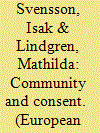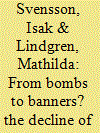| Srl | Item |
| 1 |
ID:
103669


|
|
|
|
|
| Publication |
2011.
|
| Summary/Abstract |
This study explores popular challenges against the state through nonviolent means. Although previous research has started to examine the effect of these 'unarmed insurrections', the relationship between challenging the state apparatus (vertical legitimacy) and the state identity (horizontal legitimacy) has not been adequately addressed. We argue that unarmed insurrections are most likely to be successful when challenging the vertical, rather than the horizontal, legitimacy of the state. Studying data for 287 years of protests in 57 non-democratic countries during the period of 1946-2006, we find support for three implications of this proposition: 1) campaigns that demand governmental regime change are more successful than campaigns for territorial changes; 2) success is less likely when the identity of the insurgents and the government is split along ethnic lines; and 3) success is less likely when society is highly polarized along ethnic lines rather than being ethnically homogeneous. Thus, when the community is divided, the efforts to withdraw consent will be less effective. The study discusses the implications of these findings for policymakers and scholars interested in nonviolent strategic action.
|
|
|
|
|
|
|
|
|
|
|
|
|
|
|
|
| 2 |
ID:
106364


|
|
|
|
|
| Publication |
2011.
|
| Summary/Abstract |
One of the most important debates in the field of peace and conflict research concerns whether wars and armed conflicts are declining over time. The region where this plays out most markedly is East Asia: having suffered some of the world's most brutal wars in the period prior to 1979, the region has since witnessed an era of relative peacefulness. This article asks whether the decline in the level of war in the region reflects a change in the means used to pursue conflicts: are conflicts that previously were fought with arms increasingly manifested through unarmed uprisings based on strategic nonviolent actions? Examining the empirical patterns of armed conflicts and unarmed uprisings in the region, the article shows that there has been a substantial increase in the number of unarmed uprisings in East Asia that runs parallel with a decrease in the intensity and frequency of warfare. Yet, the article also shows that these nonviolent uprisings do not follow on from previous armed campaigns, and that armed and unarmed campaigns differ in terms of aims, nature and outcome. Thus, the article concludes that there is little support for the hypothesis that those who formerly used violence have shifted to new nonviolent, unarmed tactics, and that we are rather witnessing two parallel, unrelated processes. These insights call for an enlargement of the research agenda of the 'East Asian peace'.
|
|
|
|
|
|
|
|
|
|
|
|
|
|
|
|